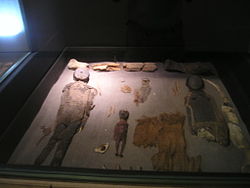- Chinchorro mummies
-
The Chinchorro mummies are mummified remains of individuals from the South American Chinchorro culture found in what is now northern Chile and southern Peru. They are the oldest examples of mummified human remains, dating to thousands of years before the Egyptian mummies. They are believed to have first appeared around 5000 BC and reaching a peak around 3000 BC. Often Chinchorro mummies were elaborately prepared by removing the internal organs and replacing them with vegetable fibers or animal hair. In some cases an embalmer would remove the skin and flesh from the dead body and replace them with clay. Shell midden and bone chemistry suggest that 90% of their diet was seafood. Many ancient cultures of fisherfolk existed, tucked away in the arid river valleys of the Andes, but the Chinchorro made themselves unique by their dedicated preservation of the dead.
The Chinchorro mummies are significant because during the periods of these mummies, everyone who died was mummified, including children, new-borns and fetuses. This shows that it was not reserved for those of high rank or high status - mummification was not a sign of social stratification.
Radiocarbon dating reveals that the oldest discovered Chinchorro mummy was that of a child from a site in the Camarones Valley, about 60 miles south of Arica and dates from around 5050 BC. The mummies continued to be made until about 1800 BC, making them contemporary with Las Vegas culture and Valdivia culture in Ecuador and the Norte Chico civilization in Peru.
The Chinchorro mummies are the earliest examples of the deliberate preservation of the dead. The mummies may have served as a means of assisting the soul in surviving, and to prevent the bodies from frightening the living.[1]
Contents
Chinchorro mummification
While many cultures throughout the world have sought to preserve the dead elite, the Chinchorro tradition performed mummification on all members of their society, including children and miscarried fetuses. Because of this egalitarian preservation of the dead, hundreds of mummies have been excavated and hundreds more remain. The oldest mummies recovered from the Atacama Desert are dated between 6000 BC and 5000 BC, the oldest yet found. To put this in perspective, the earliest mummy that has been found in Egypt dated around 3000 BC.[2]
Preparation of mummies
The manner in which the Chinchorro mummified their dead changed over the years, but several traits remained constant throughout their history. In excavated mummies, the skin had been set aside and all soft tissues and organs, including the brain, had been removed from the corpse. There is even evidence that the bone marrow was removed from the femurs of one mummy, but this has not yet been identified as a frequent occurrence. After the soft tissues had been removed, the bones were reinforced with sticks and the skin was stuffed with vegetable matter before reassembling the corpse. The mummy was then given a clay mask, though some mummies were completely covered in clay, wrapped in reeds and left to dry out for 30 – 40 days.
Techniques
The two most common techniques used in Chinchorro mummification were the Black mummies and the Red mummies.
The Black mummy technique (5000 to 3000 BC) involved taking the dead person's body apart, treating it, and reassembling it. The head, arms, and legs were removed; the skin was often removed, too. The body was heat-dried, and the flesh and tissue were completely stripped from the bone. After reassembly, the body was then covered with a white ash paste, filling the gaps left by the reassembling process. The paste was also used to fill out the person's normal facial features. The person's skin (including facial skin with a wig attachment of short black human hair) was refitted on the body, sometimes in smaller pieces, sometimes in one almost-whole piece. Sometimes sea lion skin was used as well. Then the skin (or, in the case of children, who were often missing their skin layer, the white ash layer) was painted with manganese giving them a black color.
The Red mummy technique (2500 BC to 2000 BC) was a technique in which rather than disassemble the body, many incisions were made in the trunk and shoulders to remove internal organs and dry the body cavity. The head was cut from the body so that the brain could be removed. The body was packed with various materials to return it to somewhat more-normal dimensions, sticks used to strengthen it, and the incisions sewn up. The head was placed back on the body, this time with a wig made from tassels of human hair up to 60 cm long. A "hat" made out of clack clay held the wig in place. Except for the wig and often the (black) face, everything was then painted with red ochre.
The final style of Chinchorro mummification was the mud-coat. Artisans no longer removed the organs of the dead, instead a thick coat of mud, sand and a binder like egg or fish glue was used to cover the bodies. Once completed the mummies were cemented into their graves. The change in style may have come from exposure to outsiders and their different cultures or from the association of disease with the rotting corpses. This style of mummification lasted for 200 year, until the Chinchorro disappeared.
See Also
External links
- Chinchorro Archaeological site in Chile
References
- ^ "The Chinchorro Mummies; Interview with Bernardo Arriaza". Artlives. 2007. http://artslivres.com/ShowArticle.php?Id=211. Retrieved 2007-10-25.
- ^ "Wooden coffin yields oldest Egyptian mummy". The News In science. 2003. http://www.abc.net.au/science/news/stories/s821961.htm. Retrieved 2011-01-10.
Categories:- Mummies
- Human remains (archaeological)
- History of South America
- Archaeology of Chile
- Archaeology of Peru
- Indigenous culture of the Andes
Wikimedia Foundation. 2010.


